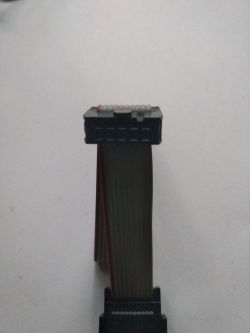Hello electrodes.
This time, the aim of the article will be to introduce you to another cheap and very useful programmer from our slant-eyed brothers.

It is a UBSASP programmer, version 2.0, designed to work with AVR systems manufactured by Atmel.
After purchase, we receive a programmer in the form of a USB "dongle" and a cable / ribbon with a standard 10-pin Kanda connector.



As you can see in the pictures, the workmanship is quite correct, although we already know that sometimes they can do it better.
The programmer is based on the Atmega8A microcontroller, and the source codes can be found at http://www.fischl.de/usbasp. Which suggests that once again we are dealing with a cheap clone.
In the attachment you have a PDF with instructions in English.
Let's move on to the capabilities of the device. The programmer supports the following systems:
Mega series:
ATmega8, ATmega8A, ATmega8U2, ATmega8HVA, ATmega16, ATmega16A,
ATmega16HVA, ATmega16HVB, ATmega16M1, ATmega16U2, ATmega16U4,
ATmega32, ATmega32A, ATmega32C1, ATmega32HVB, ATmega32M1, ATmega32U2,
ATmega32U4, ATmega32U6, ATmega48, ATmega48P, ATmega48PA, ATmega64, ATmega64A,
ATmega64C1, ATmega64M1, ATmega88, ATmega88P, ATmega88PA, ATmega103, ATmega128,
ATmega128A, ATmega128RFA1, ATmega161, ATmega162, ATmega163, ATmega164P, ATmega164PA,
ATmega165, ATmega165P, ATmega168, ATmega168P, ATmega168PA, ATmega169, ATmega169P,
ATmega323, ATmega324, ATmega324PA, ATmega325, ATmega325P, ATmega328P, ATmega329,
ATmega329P, ATmega406, ATmega640, ATmega644, ATmega644P, ATmega644PA, ATmega645,
ATmega649, ATmega1280, ATmega1281, ATmega1284P, ATmega2560, ATmega2561, ATmega3250,
ATmega3250P, ATmega3290, ATmega3290P, ATmega6450, ATmega6490, ATmega8515, ATmega8535,
Tiny series:
ATtiny10, ATtiny11, ATtiny12, ATtiny13, ATtiny13A, ATtiny15, ATtiny22, ATtiny24, ATtiny24A,
ATtiny25, ATtiny26, ATtiny28, ATtiny43U, ATtiny44, ATtiny44A, ATtiny45, ATtiny48, ATtiny84,
ATtiny85, ATtiny88, ATtiny167, ATtiny261, ATtiny261A, ATtiny461, ATtiny861, ATtiny861A, ATtiny2313, ATtiny2313A
Classic series:
AT86RF401, AT90S1200,
AT90S2313, AT90S2323, AT90S2343, AT90S4414, AT90S4433,
AT90S4434, AT90S8515, AT90S8535, AT90SCR100H, AT90USB82,
AT90USB162, AT90USB646, AT90USB647, AT90USB1286, AT90USB1287,
CAN series:
AT90CAN32, AT90CAN64, AT90CAN128
PWM series:
AT90PWM2, AT90PWM2B, AT90PWM3, AT90PWM3B,
AT90PWM81, AT90PWM216, AT90PWM316
As for a device for PLN 4, we have quite a large range of microcontrollers at our disposal.
A very useful, for some, functionality may be the ability to upload Boot Loaders to microcontrollers for Arduino.
The programmer offers us the following options:
- upload to the microcontroller the contents of the EEPROM and the appropriate firmware;
- setting fuste bits and lock bits;
- reading the contents of the above;
- work in Windows systems (including all sevens, for the higher ones, I don't know), Linux, Mac OS X;
- declaring the voltage of the programmed microcontroller, we have 5V, 3.3V and no power supply (set with a jumper), if, for example, the system is soldered into the board of a working device and powered directly from it;
- "for bajeru" we have two more LEDs, RX and TX, signaling receiving and transmitting data.
The older version also had a jumper slowing down the hardware clock speed below 1.5MHz, for programming low clock speeds. In version 2.0, the slowdown occurs automatically.
We have a number of programs to operate the programmer, or rather graphic overlays for AVRDude. The most popular of them are:
- SinaProg
- eXtreme Burner - AVR
- Khazama AVR Programmer
Summarizing. A small and very useful programmer, which should appear with every electronics in a drawer / suitcase / pocket (it will easily fit in the pocket next to the one described last week).
This time, the aim of the article will be to introduce you to another cheap and very useful programmer from our slant-eyed brothers.

It is a UBSASP programmer, version 2.0, designed to work with AVR systems manufactured by Atmel.
After purchase, we receive a programmer in the form of a USB "dongle" and a cable / ribbon with a standard 10-pin Kanda connector.



As you can see in the pictures, the workmanship is quite correct, although we already know that sometimes they can do it better.
The programmer is based on the Atmega8A microcontroller, and the source codes can be found at http://www.fischl.de/usbasp. Which suggests that once again we are dealing with a cheap clone.
In the attachment you have a PDF with instructions in English.
Let's move on to the capabilities of the device. The programmer supports the following systems:
Mega series:
ATmega8, ATmega8A, ATmega8U2, ATmega8HVA, ATmega16, ATmega16A,
ATmega16HVA, ATmega16HVB, ATmega16M1, ATmega16U2, ATmega16U4,
ATmega32, ATmega32A, ATmega32C1, ATmega32HVB, ATmega32M1, ATmega32U2,
ATmega32U4, ATmega32U6, ATmega48, ATmega48P, ATmega48PA, ATmega64, ATmega64A,
ATmega64C1, ATmega64M1, ATmega88, ATmega88P, ATmega88PA, ATmega103, ATmega128,
ATmega128A, ATmega128RFA1, ATmega161, ATmega162, ATmega163, ATmega164P, ATmega164PA,
ATmega165, ATmega165P, ATmega168, ATmega168P, ATmega168PA, ATmega169, ATmega169P,
ATmega323, ATmega324, ATmega324PA, ATmega325, ATmega325P, ATmega328P, ATmega329,
ATmega329P, ATmega406, ATmega640, ATmega644, ATmega644P, ATmega644PA, ATmega645,
ATmega649, ATmega1280, ATmega1281, ATmega1284P, ATmega2560, ATmega2561, ATmega3250,
ATmega3250P, ATmega3290, ATmega3290P, ATmega6450, ATmega6490, ATmega8515, ATmega8535,
Tiny series:
ATtiny10, ATtiny11, ATtiny12, ATtiny13, ATtiny13A, ATtiny15, ATtiny22, ATtiny24, ATtiny24A,
ATtiny25, ATtiny26, ATtiny28, ATtiny43U, ATtiny44, ATtiny44A, ATtiny45, ATtiny48, ATtiny84,
ATtiny85, ATtiny88, ATtiny167, ATtiny261, ATtiny261A, ATtiny461, ATtiny861, ATtiny861A, ATtiny2313, ATtiny2313A
Classic series:
AT86RF401, AT90S1200,
AT90S2313, AT90S2323, AT90S2343, AT90S4414, AT90S4433,
AT90S4434, AT90S8515, AT90S8535, AT90SCR100H, AT90USB82,
AT90USB162, AT90USB646, AT90USB647, AT90USB1286, AT90USB1287,
CAN series:
AT90CAN32, AT90CAN64, AT90CAN128
PWM series:
AT90PWM2, AT90PWM2B, AT90PWM3, AT90PWM3B,
AT90PWM81, AT90PWM216, AT90PWM316
As for a device for PLN 4, we have quite a large range of microcontrollers at our disposal.
A very useful, for some, functionality may be the ability to upload Boot Loaders to microcontrollers for Arduino.
The programmer offers us the following options:
- upload to the microcontroller the contents of the EEPROM and the appropriate firmware;
- setting fuste bits and lock bits;
- reading the contents of the above;
- work in Windows systems (including all sevens, for the higher ones, I don't know), Linux, Mac OS X;
- declaring the voltage of the programmed microcontroller, we have 5V, 3.3V and no power supply (set with a jumper), if, for example, the system is soldered into the board of a working device and powered directly from it;
- "for bajeru" we have two more LEDs, RX and TX, signaling receiving and transmitting data.
The older version also had a jumper slowing down the hardware clock speed below 1.5MHz, for programming low clock speeds. In version 2.0, the slowdown occurs automatically.
We have a number of programs to operate the programmer, or rather graphic overlays for AVRDude. The most popular of them are:
- SinaProg
- eXtreme Burner - AVR
- Khazama AVR Programmer
Summarizing. A small and very useful programmer, which should appear with every electronics in a drawer / suitcase / pocket (it will easily fit in the pocket next to the one described last week).
Cool? Ranking DIY






